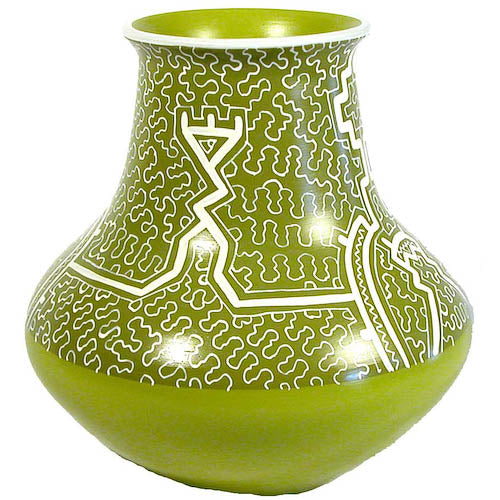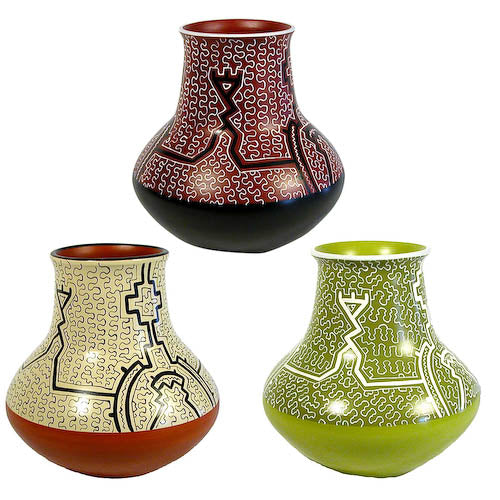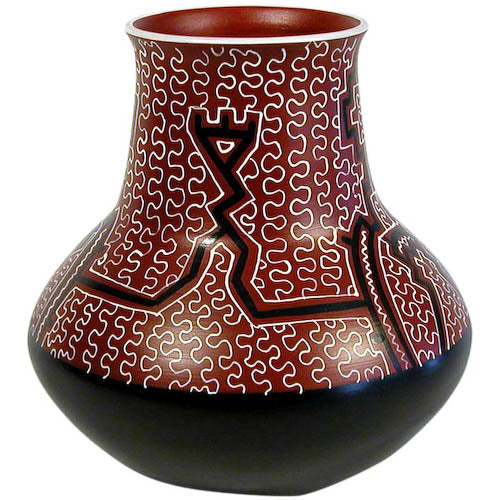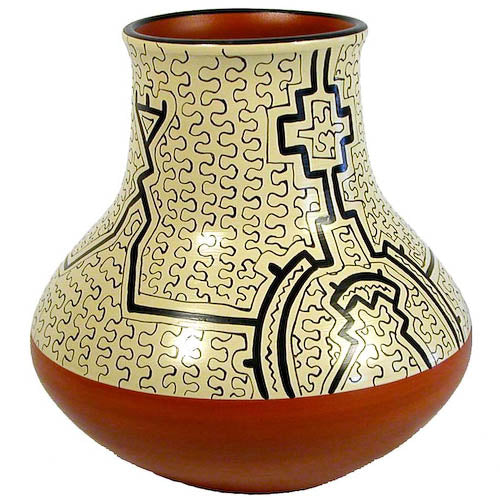OWP
Olla redondeada Shpibo con tapa apilable para estufa - Perú
Olla redondeada Shpibo con tapa apilable para estufa - Perú
No se pudo cargar la disponibilidad de retiro
Agregue color y cultura a cualquier habitación de la casa con una Olla Redondeada Shipibo de cerámica hecha a mano del Perú. Su estufa apilable la hace perfecta para flores secas, bambú o simplemente como una interesante pieza de decoración del hogar que celebra la rica historia del Perú.
La tribu Shipibo, uno de los pueblos étnicos más antiguos del Perú, mantiene una fuerte identidad tribal, antiguas tradiciones chamánicas y un sentido duradero de comunidad y sabiduría colectiva. Asimismo, los artesanos shipibo comparten una inspiración artística común que les permite colaborar en piezas grandes, trabajando indistintamente para desarrollar artes y cerámicas cohesivas que muchos piensan que han sido pintadas a mano por un solo artista.
- Mide 9" de alto x 8 3/4" de diámetro
- Disponible en cereza, verde o blanco
Hecho a mano en Perú e importado de comercio justo.
El arte shipibo es conocido por sus intrincados diseños, pero poco comprendido por el mundo exterior. Algunos antropólogos consideran los patrones geométricos una forma de lenguaje antiguo; otros especulan que representan una cosmología antigua, el mapeo de los ríos Amazonas o las formas de una anaconda. Si bien los antropólogos no están de acuerdo sobre el significado exacto, los amantes del arte pueden disfrutar del diseño elaborado, las curvas suaves y el peso ligero de cada pieza, que está hecha a mano sin el uso de tornos de alfarería.
La cerámica Shipibo se ha vuelto más compleja con el tiempo, con patrones sofisticados que pasan de una generación de artesanos a la siguiente. Los artesanos shipibo, a menudo mujeres de la aldea, no reciben capacitación formal. Más bien, se inspiran colectivamente para crear sus patrones distintivos y trabajar juntos para producir una sola pieza. Para un observador, cada mujer parece movida por el mismo espíritu artístico; una mujer puede interrumpir su trabajo y asignar a otro artesano para completar esa pieza en particular. El arte terminado parecerá hecho por un solo artista. Este es el arte comunitario en su máxima expresión.
Share
About the Artisans
About the Artisans
 Joyeria Semilla meaning Seed Jewelry is a small fair-trade workshop in the Andean town of Villa de Leyva, Colombia. Girasol Taborda, a local artisan and social entrepreneur, started the workshop in the mid-1990s.
Joyeria Semilla meaning Seed Jewelry is a small fair-trade workshop in the Andean town of Villa de Leyva, Colombia. Girasol Taborda, a local artisan and social entrepreneur, started the workshop in the mid-1990s.
Joyeria Semilla’s objective is three-folds; to create new jobs, revive Colombia's handicrafts sector and to motivate locals to better manage their natural resources. The organization works primarily with socially and economically disadvantaged youths, single mothers and people with disabilities in the area. The company offers free training in product design, technical training and marketing to new members. Joyeria Semilla has trained them in the craft of jewelry-making.

Caña Flecha or “Gynerium Sagittatum” is a locally found palm tree in the regions of the Caribbean coast. The leaves from this plant are used for making jewelry, woven hats, bags and baskets. The Zenú Indians were and their descendants inherited the tradition of picking veins of the green palm leaf for weaving. These veins were made into woven hats and other products for their personal use.
The Zenú culture is said to have existed between 200BC to1600AD. With the arrival of the colonizers in the 16th century, the indigenous community declined of unknown reasons. Today a very small population remains that claims the inheritance of the almost extinct Zenú tribe. Known for their skills in the construction of major waterworks, canals and irrigation system along with being skilled goldsmiths, examples of their accomplished craftsmanship are found in various museums around the world. Their larger means of subsistence were hunting, farming, fishing and trading.
Caña Flecha is found in abundance in the region, and hence makes for a sustainable and naturally available raw material for these products. Every bit of the plant is utilized – from using in building walls and roofs in houses to food for cattle and medicinal purposes. It is from the central vein of the leaf that the fibers for weaving are obtained. After the hard surface is peeled off, the fibers are left in the sun to dry and undergo a natural tinting process; these fibers are barely about 1 millimeter in thickness and hence call for a lot of skill and patience to weave with. The dried fibers are then processed for natural coloration - some are boiled with lemon to whiten them and some are treated with mud and boiled with plantain leaves to blacken them. The designs are based on ancient motifs and mathematical representations, which are inspired by the early Zenú culture.








